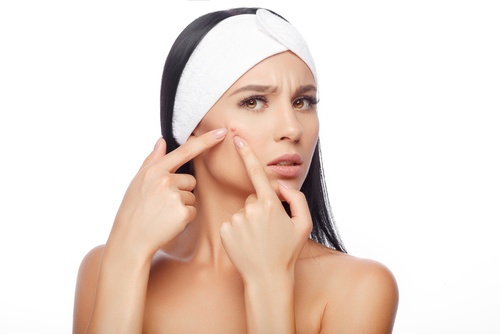

Acne is one of the most common skin conditions around. It’s a skin ailment that people of all races can suffer from, and at all ages. Acne directly affects the skin’s oil glands – and the lesions most often occur on the face, neck, chest, back, and shoulders. In the majority of cases, acne is not a serious health risk, although severe cases can lead to permanent scarring. The worst situation for most sufferers is the emotional distress and self-esteem anguish. Laser acne treatment, when performed by a professional in the field, can make a big difference, and with excellent results.
Human skin is covered with thousands and thousands of microscopic hair follicles (particularly in areas like the face, neck, chest, and back). Acne, sometimes referred to as “acne vulgaris”, is a result of over-productive sebaceous glands (the glands in the skin that secrete an oily “sebum” through the hair follicles). Clearly, there’s a  connection between acne and hair follicles.
connection between acne and hair follicles.
Over the long term, when the hair follicles are clogged with oil and debris, acne begins to emerge as blackheads, whiteheads, and pimples. And because excess “sebum” isn’t draining properly through the skin, there’s a potential for bacteria to grow, and acne lesions start to develop. This is where laser acne treatment can be an effective treatment, especially in the early stages.
With “non-inflammatory” acne, existing pimples can spontaneously get unplugged and actually heal. Or, they become non-inflamed blemishes called comedones (whiteheads or blackheads).
With “inflammatory” acne, a blackhead or whitehead can rupture – either randomly or by picking at the skin. That’s why it’s important not to touch acne-prone skin and disturb the blemishes.
Lumenis® IPL (also referred to as Intense Pulsed Light) uses intense flashes of light to treat acne scars. Each treatment activates a biochemical response in the skin that kills acne bacteria at the source. Lumenis® IPL is non-invasive treatment, and is effective after acne lesions have healed.
In treating acne, IPL uses short pulses of intense light that penetrates the skin. In this way, acne bacteria is attacked and killed in the skin pore. In addition, the treatment reduces any inherent inflammation. Treatments vary with severity, but several sessions are required for good results.
For most clients, skin-care experts will recommend from 4 to 6 IPL treatments as a protocol. Also recommended is a 4-week “recess” between treatments. After each treatment, some clients may experience some skin redness, but this dissipates quickly. Daily routine can resume immediately.
Without question, Lumenis® IPL should be performed by a skin care expert who has experience. Since all skin treatments pose some risk, it’s very important to work with a skin care professional to understand the pros and cons of treatment. Lumenis® IPL is approved by Health Canada.
Acne is most common with teenagers and young adults. It’s estimated that 80% of people between of 10 and 30 will have an acne outbreak at some point. In fact, there are people in their 40s and 50s who get acne as well. Notwithstanding the physical issues that surround acne, it’s the psychological aspects that are most debilitating - like poor self-esteem and poor self-image. With professional laser acne treatment, both physical and psychological issues can be well managed.
A natural and non-invasive treatment to improve skin tone, while moisturizing the skin.
learn moreNo more blemishes and embarrassing breakouts. Check out or solutions to acne breakouts.
learn moreThe short answer is Yes.. Treatment with Intense Pulsed Light (IPL) has proven effective in treating many acne conditions. IPL uses specific wavelengths of light to target acne bacteria, as well as inflamed sebaceous glands, which contribute to acne breakouts. With IPL technology, technicians can vary the wavelengths of light, thus destroying skin pigment clusters and blood-filled capillaries. IPL can be customized for specific conditions, and with excellent results.
According to the Acne and Rosacea Society of Canada, acne was once considered a teenager-only skin condition. However, over the years, it’s become clear that skin acne is a common occurrence with adults - especially with women between the age of 20 and 40. Statistically, approximately one-third of all acne patients are 25 years or older (with conditions that are caused primarily by hormones, genetics, or stress). Treatment approaches are much the same, regardless of age.
Not necessarily. Skin acne can appear in any part of the body where there are sebaceous glands. Acne develops when hair follicles are blocked with sebum (produced by sebaceous glands). When hair follicles are clogged with excess sebum, “acne bacteria” begin to develop. And while the sebaceous glands occur in various parts of the body, they are prominent in certain areas. That’s why skin acne often appears on the scalp, the face, the shoulders, and the upper back and chest.
Please, enter a valid value

We will contact you within 1 business day.
Please, enter a valid value